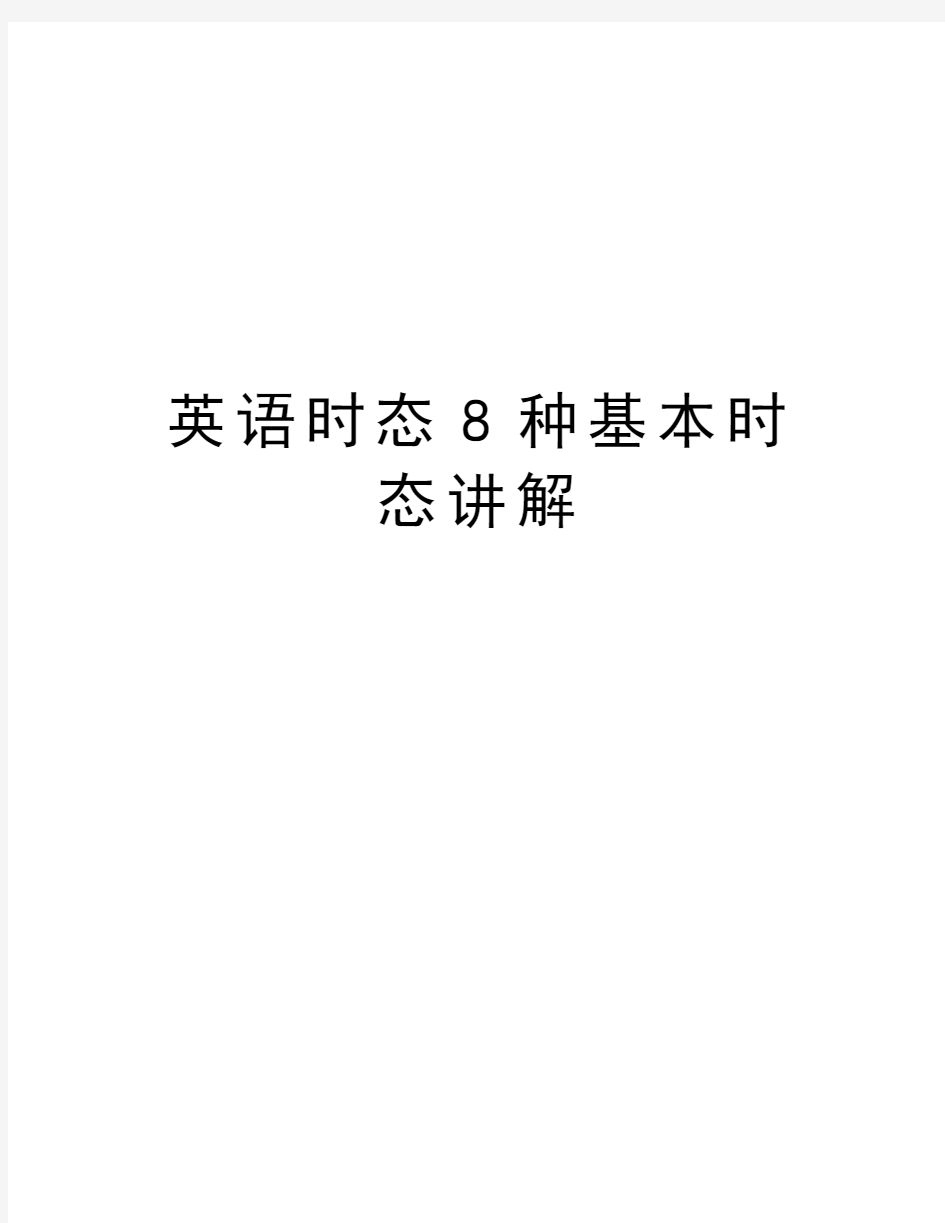

英语时态8种基本时
态讲解
英语时态8种基本时态讲解
一.概念:英语中表示不同时间发生的动作或存在的状态,需用不同的动词形式表示,这种不同的动词形式称为时态。
二.种类:(基本时态)
一般现在时一般过去时
现在进行时过去进行时
一般将来时过去将来时
现在完成时过去完成时
三.用法:
1)一般现在时表示经常发生或习惯性的动作或状态及客观现实和普遍真理。
一般现在时常以动词原形表示,但当主语是第三人称单数时,动词词尾加-s或-es。
2)句型结构:主语+V.(包括be动词)+宾语+…
She is an engineer.
He has breakfast at 6:00every day.
3)注意:一般现在时通常与always , often , usually , every day , sometimes , once a week 等时间状语连用。
1)一般过去时表示发生在过去的动作或存在的状态,通常与表示过去的时间状语yesterday, last night ,some years ago, in 1990,in those days.等连用。
I was a student 6 years ago.
2)句型结构:主语+V.过去时+宾语+…例句:昨天他很忙
3)否定句和疑问句。a)----He was busy yesterday. -----He wasn’t busy. -----Was he busy?-----Yes, he was./ No, he wasn’t.
4)动词过去式变化规则。
a)一般情况下的词加-ed.
work---worked call----called
b)以不发音的字母e结尾的单词直接加-d .
live----lived change----changed smoke----smoked die----died
graduate----graduated drive----drove
c)以“辅音字母+y”结尾的单词,变y为i加-ed.
study----studied carry----carried cry----cried
try----tried marry----married
d)以“元音字母+y”结尾的单词直接加-ed.
play----played stay----stayed
e)以“一个元音字母+一个辅音字母”结尾的单词应先双写这个辅音字母然后再加-ed. stop----stopped plan----planned pat----patted
f)动词不规则变化:
do----did go----went come----came run----ran write----wrote
begin----began drink----drank keep----kept leave----left sleep----slept
make----made lie----lay dig----dug eat----ate know----knew
cut----cut set----set let----let read----read hurt----hurt
例句:我前天拿走了这本书。
去年我买了一辆自行车。
每天晚上我听音乐。
表示将来发生的动作或存在的状态,常与表将来的时间状语tomorrow, the day after tomorrow, next Sunday, soon, in a few days等连用。
2)句型结构:主语+will/shall+V.原形+…(第一人称用shall)
I shall go to Shanghai tomorrow.
They will have a meeting next week.
----She will be 20 years old.
----Will she be 20 years old?
----Yes, she will./ No, she won’t .
3)主语+will/shall+V.原形+…
be(am, is, are)going to
They will have a meeting next Sunday.
(will=are going to )
----What will they do next Sunday ?
----When will they have a meeting?
4) be about to+V.原形
I am about to leave school.
不能与表示时间的副词连用。
They are about to set out.(√)
They are about to set out soon.(×)
复习题:
1.He (do) his homework at school every day.
2.They (finish) their work yesterday.
5.他将骑自行车去学校
)过去将来时是立足于过去某时,从过去的观点看将要发生的动作或状态。主要用于宾语从句中。
2)基本结构:主语+would/should was/were going to +V.原形+…
He said that he would have a meeting next week.
1)现在进行时表示现在或现在这段时间正在进行的动作。通常与now, at present 等时间状语连用。
2)基本结构:主语+be(am, is, are)+ v-ing +…
You are listening to me carefully now.
3)动词现在分词的构成
①一般动词直接在词后加-ing
do – doing read – reading
②以不发音的字母e 结尾的动词,应先去掉 e 然后加– ing
like – liking take – taking
leave – leaving live – living
receive – receiving dance – dancing
③以“一个元音字母 + 一个辅音字母”结尾的动词,应先双写这个辅音字母然后再加-ing stop – stopping begin – beginning
dig – digging swim – swimming
run – running sit – sitting
(注意:listen – listening open – opening eat – eating